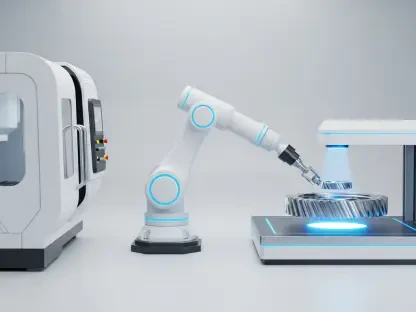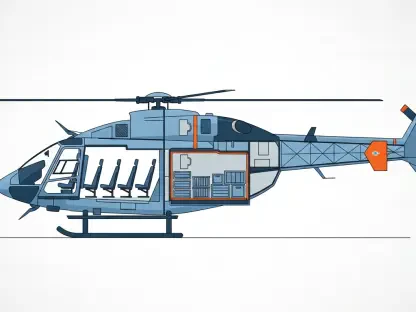Ferrari’s strategic integration of 3D printing technology into the newly launched F80 supercar marks a groundbreaking evolution in the automotive industry. This article delves into how this luxury car manufacturer is pioneering high-performance engineering through advanced manufacturing techniques, focusing on the significance of incorporating additively manufactured (AM) structural components into road cars. The F80 has been unveiled, capturing the essence of cutting-edge advancements in power, design, and technology. The most striking feature of the F80 is its use of 3D printing technology for essential structural components, representing Ferrari’s initial venture into employing AM in road vehicles. This innovation signals a significant milestone, demonstrating Ferrari’s transition from using 3D printing in motorsport to its consumer road cars.
Hybrid Powertrain and Performance
The F80 boasts a hybrid powertrain that generates an astonishing 1,200 horsepower. This power is achieved through a 3.0-liter twin-turbocharged V6 engine paired with three electric motors. Ferrari has managed to blend high-performance engineering with sustainable technology, producing a vehicle capable of both speed and efficiency. The vehicle’s impressive capabilities include accelerating from 0 to 62 mph in just 2.15 seconds and exceeding a top speed of 200 mph. While these performance metrics are remarkable, the real innovation lies in Ferrari’s clever utilization of 3D printing technology to optimize these performance figures. Integrating AM components helps to significantly reduce weight, enhancing both speed and handling.
This powertrain is a testament to Ferrari’s commitment to pushing the boundaries of engineering while embracing green technology. The hybrid system not only provides the necessary throttle response and top speeds expected from a Ferrari but also incorporates a degree of environmental responsibility. Ferrari’s clever use of advanced manufacturing technologies, such as 3D printing, has certainly played a role in making these lofty performance figures possible. Reducing the car’s overall weight streamlines the integration of powerful electric motors, which are crucial for both acceleration and maintaining high speeds. This integration epitomizes Ferrari’s vision of the future, where high performance and sustainability go hand in hand.
Technical Milestones: 3D Printing Structural Components
The application of metal 3D printing in the F80 encapsulates a pivotal technical achievement. Leveraging its extensive experience in Formula 1 motorsport, Ferrari incorporates additively manufactured components such as the upper wishbones in the F80’s active suspension system. This transition represents a sophisticated merging of racing technology with consumer vehicle production. The 3D printed upper wishbones benefit from a significant reduction in unsprung mass. This optimization directly impacts the suspension geometry, resulting in enhanced handling and stability. By pioneering the use of AM, Ferrari achieves increased performance capabilities while maintaining structural integrity—an essential requirement for high-speed vehicles.
Besides the suspension components, many other intricate parts of the F80 benefit from 3D printing. These components are designed to withstand the enormous stresses encountered at high speeds and extreme driving conditions. The upper wishbones, in particular, showcase the effectiveness of AM in reducing weight while maintaining the strength required for superior performance. Ferrari’s adoption of this technology can be seen as a translation of the high-tech, high-stakes world of Formula 1 into everyday road cars. This effort not only underscores Ferrari’s technical prowess but also sets a precedent for future applications within the automotive sector.
Advantages of 3D Printing in Automotive Manufacturing
Traditional manufacturing methods often limit the complexity and efficiency of components. By contrast, 3D printing allows for the creation of lighter, stronger parts with intricate geometries that are difficult or impossible to achieve through conventional techniques. This step towards innovation not only elevates design but also functional performance. The intricate design capabilities afforded by 3D printing contribute to better aerodynamics, superior performance, and improved ride quality. These enhancements are critical in high-speed cars like the F80. Moreover, the customizability of 3D printed components permits bespoke solutions tailored to specific performance requirements, setting a new standard in the manufacturing process.
Another advantage of 3D printing in automotive manufacturing is the significant reduction in production time. Custom components that would typically take weeks to design and manufacture can now be produced in a fraction of that time. This efficiency allows for rapid prototyping, enabling engineers to test and refine designs more quickly. Additionally, 3D printing minimizes material waste, making it a more sustainable option compared to traditional manufacturing methods. As the technology continues to evolve, these advantages are likely to become even more pronounced, revolutionizing not only high-performance cars like the F80 but also mass-market vehicles.
Advanced Suspension System
In the F80, the 3D printed upper wishbones are integral to a sophisticated active suspension system. This setup includes four electric motors, a double wishbone layout, and active inboard dampers. The precision and flexibility of 3D printing permit Ferrari to refine the suspension arrangement meticulously, ensuring unparalleled performance. The removal of anti-roll bars and the introduction of camber angle correction illustrate how Ferrari uses AM to push the boundaries of conventional vehicle dynamics. This dual-purpose system provides a flat ride on the track while ensuring comfort and stability on regular roads, meeting a broad spectrum of driving conditions and enhancing the driving experience.
Ferrari’s advanced suspension system in the F80 stands as a testament to how the integration of 3D printing technology can elevate vehicle dynamics. The use of 3D printed components in the suspension system allows for precise adjustments that enhance both performance and comfort. On the track, the suspension system ensures maximum stability and optimal handling, while on regular roads, it provides a smooth and comfortable ride. This flexibility is achieved through the precise geometry and reduced weight of the 3D printed components, which are not possible with traditional manufacturing methods. Ferrari’s innovation in this area sets a new standard for luxury supercars and paves the way for future advancements in automotive suspension systems.
Broadening Adoption of Additive Manufacturing in the Industry
Ferrari’s utilization of 3D printing in the F80 reflects a broader trend within the automotive industry. Manufacturers globally are increasingly adopting AM to produce lightweight, high-strength components designed to enhance vehicle performance and efficiency. For performance-centric brands like Ferrari, the reduction in weight and incremental gains in acceleration are crucial. For instance, Volkswagen aims to 3D print 100,000 parts annually by 2025, utilizing binder jetting technology to decrease vehicle weight and improve efficiency. BMW has also embraced 3D printing, integrating it into fully automated production lines to manufacture thousands of components. Aston Martin’s Valhalla model further exemplifies luxury vehicles benefiting from lightweight and handling improvements offered by AM.
The wider adoption of 3D printing technology in the automotive industry indicates a significant shift in manufacturing paradigms. While performance and luxury car manufacturers were the pioneers, mainstream automakers are starting to recognize the numerous benefits of AM. The precision, efficiency, and potential for customization offered by 3D printing are enticing propositions for companies focused on performance improvement and cost reduction. As more automakers integrate AM into their production lines, the technology is expected to become more accessible and economically feasible for a broader range of vehicles, from high-end sports cars to everyday family sedans.
Divergent Technologies: Pioneering Automated AM Workflow
Divergent Technologies stands at the forefront of this field, having developed a highly automated workflow for designing, 3D printing, and assembling metal components for supercars, as well as military aircraft. This Los Angeles-based tech firm previously produced a rear subframe for Aston Martin, underscoring the effective application of AM in manufacturing high-performance vehicles. The adoption of 3D printing began with high-stakes environments like motorsports and has since extended to luxury vehicles. The trajectory indicates a future where AM will become integral to mass-producing end parts for everyday vehicles. The scalability and economic potential of this technology are immense, promising to revolutionize manufacturing landscapes.
Divergent Technologies exemplifies how automated workflows can revolutionize the production of high-performance components. Their innovative approach demonstrates the feasibility of scaling up 3D printed parts production while maintaining the high standards required for luxury and performance vehicles. The company’s work with Aston Martin showcases the practical application of 3D printing technology in real-world scenarios, offering insights into how the automotive industry can leverage AM for broader use. As automated AM workflows become more refined, the potential for reducing costs, enhancing precision, and speeding up production times becomes increasingly achievable, benefiting the entire automotive sector.
Conclusion
The integration of metal 3D printing in the F80 marks a significant technical milestone. Utilizing its rich history in Formula 1, Ferrari incorporates additively manufactured parts like the upper wishbones in the F80’s active suspension system. This shift highlights the seamless blending of racing technology with consumer vehicle production. The 3D-printed upper wishbones result in a notable reduction in unsprung mass, which directly impacts suspension geometry and enhances handling and stability. By pioneering additive manufacturing (AM), Ferrari achieves higher performance while maintaining structural integrity—a crucial requirement for high-speed vehicles.
Beyond suspension components, numerous other intricate parts of the F80 benefit from 3D printing. These parts are designed to endure the stresses of high speeds and extreme driving conditions. Specifically, the upper wishbones demonstrate the effectiveness of AM in reducing weight while maintaining the requisite strength for top-tier performance. Ferrari’s adoption of this technology translates the high-tech, high-stakes world of Formula 1 into everyday road cars. This move highlights Ferrari’s technical expertise and sets a new standard for future automotive applications.









